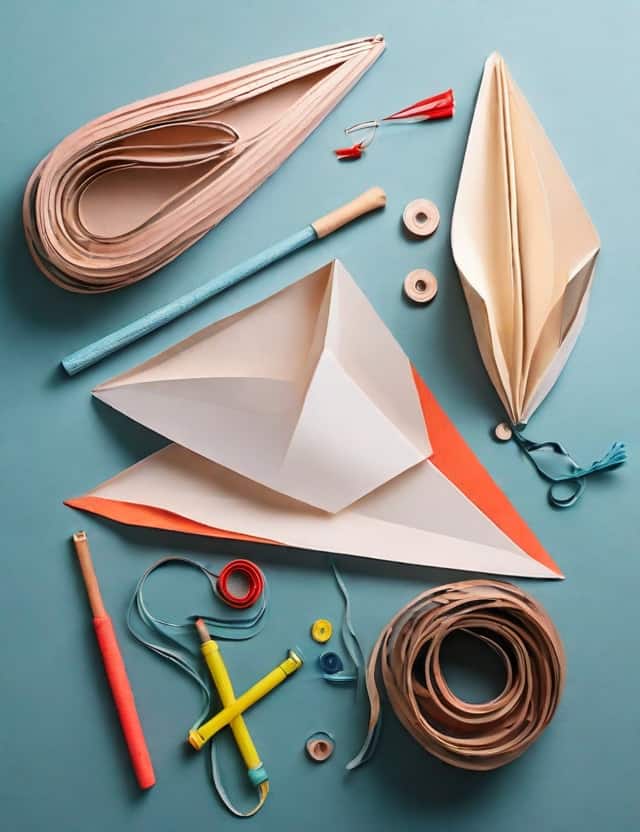The materials for creating a kite can vary depending on your desired type. However, you will need basic materials: kite paper or fabric, bamboo sticks or dowels, string or kite line, glue, scissors, and a ruler. It is important to note that the quality of these materials will affect the performance and durability of your kite.
Paper Or Sail Materials For Creating A Kite
The most common material used for making kites is paper. You can use any paper you have on hand, such as printer paper, construction paper, or tissue paper. Lightweight paper is ideal for smaller, single-line or diamond kites. This type of paper is easy to work with and easily cut and folded to create the desired shape.
The choice of paper can significantly impact the performance and aesthetics of a kite. For example, traditional single-line kites often use lightweight and colourful tissue paper to achieve a delicate and graceful appearance. The translucency of tissue paper allows sunlight to filter through, creating a beautiful visual effect during flight.
In contrast, diamond kites, known for their simplicity and stability, may be made using durable and slightly heavier paper such as Tyvek or Mylar. These materials offer increased strength and resistance to tearing, making them suitable for more robust kite designs that require sturdier construction.
If you are making a kite sail, also known as a kite canopy or kite wing, it refers to the fabric portion of the kite that catches the wind and generates lift, allowing the kite to soar in the sky. It is the aerodynamic component of the kite that harnesses the force of the wind to provide upward thrust and stability during flight.
The design and construction of the kite sail play a crucial role in determining the kite’s performance, maneuverability, and overall flying characteristics. Different kite styles, such as delta, parafoil, and diamond kites, feature distinct kite sails tailored to their specific aerodynamic requirements.
For the kite sail, you can use cloth or sail material. Nylon is a popular choice for kite sails, as it is lightweight and durable. However, any lightweight fabric can be used.

Dowels or Bamboo Stick Materials For Creating A Kite
You will need dowels or bamboo sticks for the kite frame, which you can purchase at your local hardware store. Wooden dowels are commonly used, but bamboo sticks are also a good option. The size of the dowels or bamboo sticks will depend on your kite size.
If you are constructing a large kite with a wingspan of 5 feet, you may opt for thicker and longer dowels or bamboo sticks to provide the necessary structural support. For a kite with a wingspan of 5 feet, use dowels that are approximately 1/4 to 3/8 inch in thickness. This thickness will provide the necessary strength and support for the kite structure while keeping it lightweight enough for optimal flight performance.
A smaller kite with a wingspan of 2 feet requires thinner and shorter dowels or bamboo sticks to maintain a lightweight yet sturdy frame. For a kite with a wingspan of 2 feet, dowels around 1/8 to 1/4 inch in thickness would be suitable. These thinner dowels will provide ample support for the smaller kite while maintaining its lightweight design for efficient flying.
String Materials For Creating A Kite
You will need string to attach the kite frame to the sail and to control the kite in the air. Kite string is strong and durable; however, any string or fishing line can be used.
Here are a few of the most popular strings used in kite making:
- Braided Dacron: Known for its strength and minimal stretch, braided Dacron kite string is popular for various kite sizes and designs. It offers excellent durability and is available in different thicknesses.
- Twisted Nylon: Twisted nylon kite string is valued for its durability and resistance to abrasion. It is suitable for medium to large kites, providing reliable strength and stability during flight.
- Braided Polyester: Offering high tensile strength and low stretch, braided polyester kite string is used for high performance kites and acrobatic stunt kites. It provides excellent control and responsiveness, ideal for advanced kite flying maneuvers.
- Kevlar Line: Kevlar kite line is renowned for its exceptional strength and resistance to abrasion. It is used for power and traction kites, where extreme forces are exerted, requiring a highly durable and low-stretch line.
- Fishing Line (Monofilament or Braided): While not explicitly designed for kites, certain types of fishing line, such as monofilament or braided varieties, can be used as kite string. They offer high tensile strength and low visibility, making them suitable materials for creating a kite.

Tape And Ribbon Materials For Creating A Kite
In kite making, tape and ribbon are essential in structural assembly and aesthetic embellishment. Due to its strength and durability, use duct tape to attach the sail to the frame. The adhesive properties of all tapes are excellent materials for creating a kite, provide reliable support, ensuring the sail remains securely fastened during flight. However, duct tape’s resilience allows it to withstand the stresses and strains experienced by the kite, making it a preferred choice for securing the sail to the frame.
While duct tape is commonly used, various types, including electrical, masking, or packing, can fulfill this role. Each type offers different adhesive properties and strengths, allowing for flexibility based on availability and specific kite-making requirements.
Conversely, ribbon serves a decorative purpose, adding colour and visual appeal to the kite. Ribbons can create intricate designs, patterns, or tails that enhance the kite’s appearance and make it more visually striking during flight. The lightweight and fluttering nature of the ribbon can also contribute to the kite’s overall aesthetic appeal, especially when flying in the wind.
By utilizing tape and ribbon effectively, kite makers can ensure both the structural integrity and visual charm of their creations, resulting in kites that are not only sturdy and reliable but also visually captivating.
Marker Materials For Creating A Kite
Using a marker to add designs or patterns to the kite sail presents an enjoyable and creative opportunity to personalize it, making it truly unique. Whether drawing intricate geometric patterns, adding vibrant colours, or incorporating personal artwork, decorating the kite with a marker allows endless creative expression. This process not only enhances the aesthetic appeal of the kite but also provides a means of self-expression and individuality.
The best markers for kite design are permanent markers or fabric markers. These markers are designed to create long-lasting and vibrant designs on various surfaces, including kite sails made of paper, nylon, or other fabric materials. Permanent markers offer excellent colour saturation and durability, ensuring the designs remain vivid and intact even when exposed to outdoor elements such as sunlight and wind. Fabric markers are specifically formulated to adhere to fabric surfaces, making them ideal for creating intricate and lasting designs on kite sails.

Other Options Materials For Creating A Kite
If you don’t have access or the financial ability to purchase the materials above, you can use simple materials such as plastic garbage bags, newspaper, or thick wrapping paper to make a kite. You can replace the wooden dowels with wooden sticks or even pencils.
Final Thoughts
When creating a kite, choosing suitable materials is essential to ensure that your kite flies well and lasts for a long time. By carefully selecting the suitable materials for your kite, you can create a beautiful and functional flying machine that will provide hours of entertainment for you and your family.
Frequently Asked Questions
What are the materials used in kite making competition?
Participants may choose materials based on the specific rules of the competition, the type of kite they intend to build (e.g., single-line, dual-line, or quad-line), the local weather conditions, and personal preference or experience.
Can I use regular string for my kite line, or do I need something special?
While you can use regular string for casual kite flying, it’s not recommended for larger or high-performance kites. Specialized kite line made from Dacron, Spectra, or Dyneema is stronger and more resistant to breaking and abrasion, which is important for safety and performance.
Do I need to sew the kite sail, or can I use tape?
Sewing the sail with a sewing machine is a traditional method that provides durability and strength, especially for larger or performance kites. However, for smaller kites or quick projects, special double-sided tapes designed for fabric can be used. The choice depends on the kite’s design, the flyer’s skill level, and the intended use of the kite.






